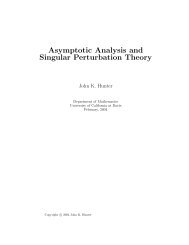18 Poisson Process
18 Poisson Process
18 Poisson Process
You also want an ePaper? Increase the reach of your titles
YUMPU automatically turns print PDFs into web optimized ePapers that Google loves.
<strong>18</strong> POISSON PROCESS 203<br />
(b) Answer the same question when T is Exponential(µ) (and of course independent of the<br />
machines. Now, by the same logic,<br />
P(T 1 < T 2 + T) = P(T 1 < T) + P(T 1 ≥ T,T 1 < T 2 + T)<br />
λ 1<br />
=<br />
λ 1 + µ + λ 1 µ<br />
.<br />
λ 1 + λ 2 λ 1 + λ 2<br />
Example <strong>18</strong>.8. Impatient hitchhikers. Two people, Alice and Bob, are hitchhiking. Cars that<br />
would pick up a hitchhiker arrive as a <strong>Poisson</strong> process with rate λ C . Alice is first in line for a<br />
ride. Moreover, after Exponential(λ A ) time, Alice quits, and after Exponential(λ B ) time, Bob<br />
quits. Compute the probability that Alice is picked up before she quits, and the same for Bob.<br />
Embed each quitting time into an appropriate <strong>Poisson</strong> process, call these A and B processes,<br />
and the car arrivals the C process. Clearly, Alice gets picked if the first event in the combined<br />
A and C process is a C event:<br />
Moreover,<br />
P(Bob gets picked)<br />
P(Alice gets picked) =<br />
λ C<br />
λ A + λ C<br />
.<br />
= P({at least 2 C events before a B event}<br />
∪ {at least one A event before either a B or a C event,<br />
then at least one C event before a B event})<br />
= P(at least 2 C events before a B event)<br />
+ P(at least one A event before either a B or a C event,<br />
then at least one C event before a B event)<br />
− P(at least one A event before either a B or a C event,<br />
(<br />
λC<br />
then at least two C events before a B event)<br />
) 2<br />
=<br />
λ B + λ C<br />
( )( )<br />
λ A λC<br />
+<br />
λ A + λ B + λ C λ B + λ C<br />
( )( )<br />
λ 2<br />
A λC<br />
−<br />
λ A + λ B + λ C λ B + λ C<br />
λ A + λ C λ C<br />
=<br />
· .<br />
λ A + λ B + λ C λ B + λ C<br />
This leaves us with an excellent hint that there may be a shorter way, and indeed there is:<br />
P(Bob gets picked) = P(first event is either A or C, then next event among B and C is C).
















